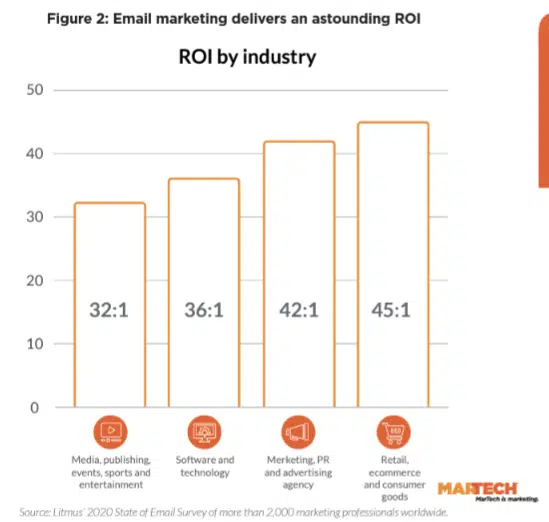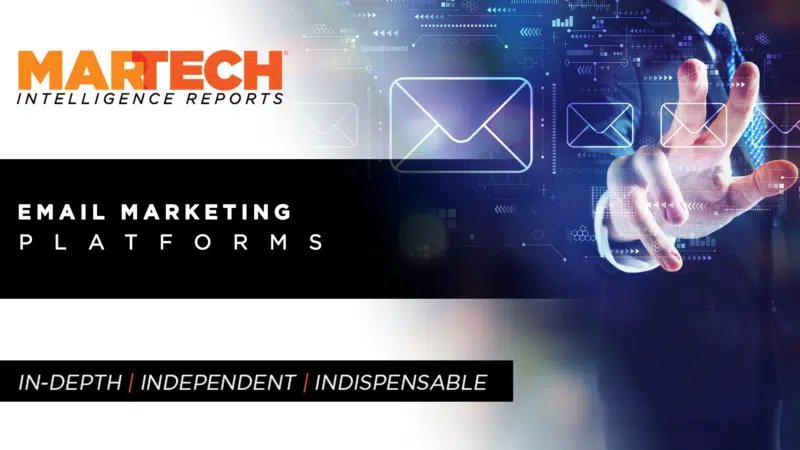A guide to how email marketing platforms help brands succeed
All email platform providers send emails, but their technologies – both software and hardware – and approaches for doing so can differ.
As excited as digital marketers get about the shiny new thing (I’m looking at you, AI), one of the first and most-established forms of online marketing – email – remains the backbone of most companies’ programs. This isn’t your grandfather’s email marketing, though. Marketers have embraced capabilities for data-driven personalization, multi-channel campaign management, audience segmentation, testing and more – some of these driven by AI and machine learning.
Email continues to grow because it delivers consistent and impressive results. For every dollar marketers spend on email marketing, they generate $36 in revenue, a Litmus survey of 2,000 email marketers found in 2020, the latest year for which data is available.
Depending on what industry you’re in, your company’s ROI could be even higher. Agencies in marketing, PR and advertising see a return of $42 for every $1 they spend on email, and businesses in retail, ecommerce and consumer goods are rewarded with $45 in revenue for each dollar spent.

The centrality of data and the need for updated technology
Email may have been around since the dawn of the internet, but the space doesn’t stand still. Email marketing, and the technology that enables it, have evolved to deal with challenges like spam and deliverability and also to take advantage of opportunities, such as the ever-increasing sophistication of data usage for hyper-personalization.
When MarTech surveyed marketers for the 2022 MarTech Replacement Survey, they said technologies for email distribution and for marketing automation (a chief component of which is email), were both in the top four software types replaced over the previous 18 months.
Dig deeper MarTech’s email marketing experts to follow
Marketing automation was the most replaced application, with 23% of respondents in 2022 saying they’d replaced it, versus 24% in 2021. Email distribution technologies were replaced by 21% of those surveyed in 2022, compared to 24% in 2021.
Most of the respondents who replaced email distribution systems were moving to a commercial application, either from another commercial vendor or a homegrown solution. The primary reason: to take advantage of new and better features.

Email marketing helps organizations acquire and retain customers, build businesses and make more money. Explore the platforms essential to email marketing in the latest edition of this MarTech Intelligence Report.
The latest generation of email technology
When it comes to technology, maturity can be a disadvantage. New businesses can more easily leverage the latest capabilities of software development, while established firms may be saddled with legacy technologies and architectures.
Of course, technology players often introduce new features – some at a higher rate than others. But doing that on top of an aging infrastructure, while also keeping things running for an existing customer base, can be challenging.
While the COVID-19 pandemic may have driven communications between business and customers to digital channels like email, that preference seems to hold up even now that the pandemic is waning. Fifty-seven percent of customers said they preferred to engage with businesses via email in 2022, down from 65% in 2020, according to Salesforce’s State of the Connected Customer report.

Despite this preference, lots of emails land in inboxes without getting an open, much less a read or a click. Meanwhile, recipients spent an average of only 10 seconds reading brand emails in the first three quarters of 2021, a Litmus analysis of eight billion email opens found. That was down from 11.8 seconds in 2020 and 13.4 seconds in 2018.
These statistics explain why marketers, and the email marketing platform vendors serving them, are focusing on technologies to create more personalized, relevant and engaging messages that improve the odds of their content being read and acted on.
The personalization imperative amid data pressures
Meanwhile, other developments are changing the data landscape, making it harder to even gather statistics like these about users’ interactions with emails. Because of efforts to safeguard customer privacy, tech companies are making it harder for marketers to collect data about individual users.
In addition to the pending demise of third-party cookies, both Apple and Google are reducing the utility of mobile ad identifiers in an effort to safeguard customer privacy. Another change affecting email marketing, in particular, arose in mid-2021 when Apple announced Mail Privacy Protection (MPP) features in iOS, Mac OS and Watch OS that can limit the data available to marketers by concealing opens and IP addresses.
Another Apple feature, Hide My Email, lets users create their own unique random email addresses that forward to their inboxes. This means that a person could use a unique email address for every business with whom they have a relationship, foiling technologies that seek to tie together behavior from different sources to get a holistic view of a customer’s interests and needs.
These changes are spurring a dramatic shift to first-party data in all digital marketing disciplines, and they have led to the decline of the open rate as a meaningful email marketing metric, since MPP obscures whether, or when, emails are opened by using a cache.
Both the increased emphasis on data-driven personalization and the shifts in the data landscape have spurred vendors of email marketing platforms to augment the data available within their platforms and change the emphasis to metrics other than open rate.
Enterprise email marketing platform capabilities
Email marketing platforms usually offer features for email creation and sending, but consolidation and integrations have added to what one might have once expected. Common capabilities of these platforms include:
- Message design and creation
- Workflow automation and collaboration
- Message previewing
- Email sending
- Deliverability management
- Data management
- Ecommerce capabilities
- Analytics and reporting
- Third-party integrations
- Automation and landing pages
Some providers may offer more advanced capabilities, such as:
- More full-featured customer data platform functionality
- Artificial intelligence and machine learning capabilities leveraged through different parts of the platform
The benefits of email marketing platforms
While any but the most nascent of businesses will likely have adopted some approach to email, given its centrality to business in general, adopting an enterprise solution offers many benefits. These may include:
- Data unification across channels. Some email marketing platforms include full-fledged customer data platforms, but, even if they don’t, the customer databases associated with these systems can serve as a single source of truth across an organization. Such unification can provide businesses with a complete portrait of their customers, permitting them to leverage data for marketing, customer service and product development purposes. Platforms can also assist with compliance with CAN-SPAM and other privacy regulations.
- A more unified technology stack overall. Most email marketing platforms offer extensive integrations with other business technologies, allowing companies to more easily work across silos.
- Ability to identify more profitable audiences and segmentation strategies. The unified data trove gives marketers the opportunity to get to know their customers better, and also to identify lookalike audiences by connecting to additional data sources. Artificial intelligence and machine learning capabilities can surface useful insights that marketers may not know to look for.
- More efficient workflows. Every email message that’s meant to be delivered to an audience or segment typically goes through an internal review and approval process. Some email marketing platforms feature the ability to collaborate and obtain approvals within the platform, which is especially helpful for larger more-distributed organizations and those in more regulated industries. Franchises and other multilocation businesses benefit from even more complex systems aimed at sharing useful assets and establishing guidelines, while also allowing those closest to the customers to add valuable customization.
- More personal and efficient communication with customers. Template design combined with data insights and segmentation can allow businesses to deliver more personalized, relevant and timely messaging. Automation and triggered-messaging features allow for more efficiency, as well. When systems include SMS or mobile notification options, this allows businesses to extend communications to those channels.
- Improved deliverability and design of email messages. Email marketing platforms’ deliverability systems – both technological and relationship-oriented – can help businesses ensure their messages make it to the inbox. Once they arrive, design and preview features give marketers more control over how their messages appear, no matter where they are viewed.
- Access to more advanced templating and interactivity. Interactive capabilities via AMP for email or CSS are more easily accessible with the help of email marketing platforms, allowing businesses to create more engaging messages with better return.
- Better ability to measure return on investment (ROI) and more. Data and reporting capabilities can tie email messages to specific business goals, allowing marketers to optimize content and targeting to achieve the best possible results.
Read more on email marketing
Personalized email subject lines

Email marketing helps organizations acquire and retain customers, build businesses and make more money. Explore the platforms essential to email marketing in the latest edition of this MarTech Intelligence Report.
Related stories
New on MarTech